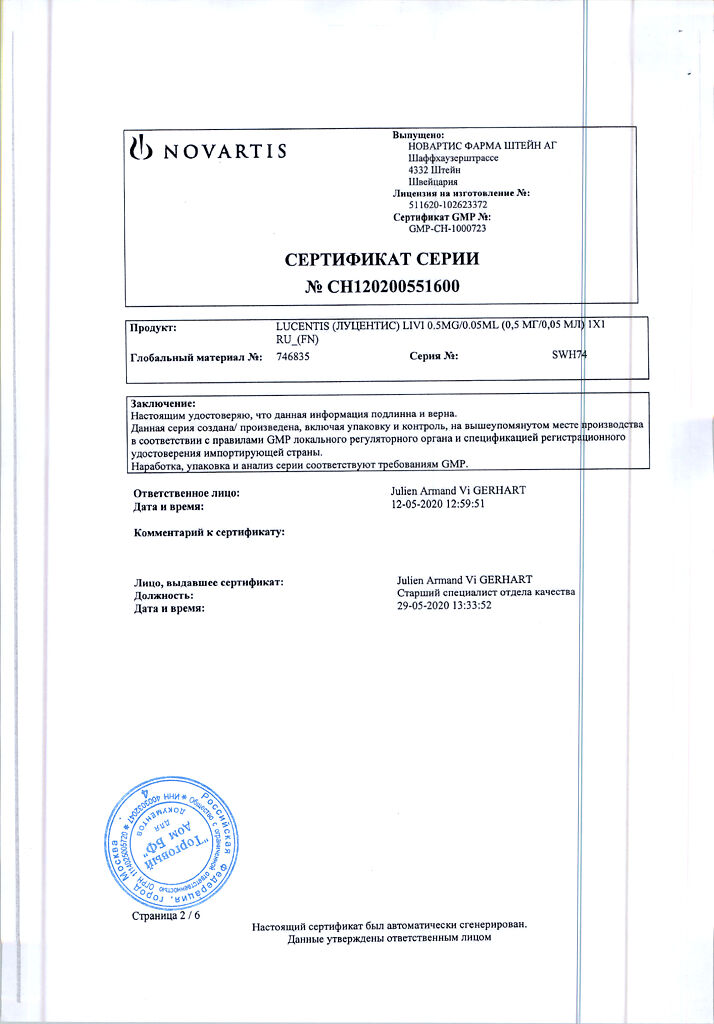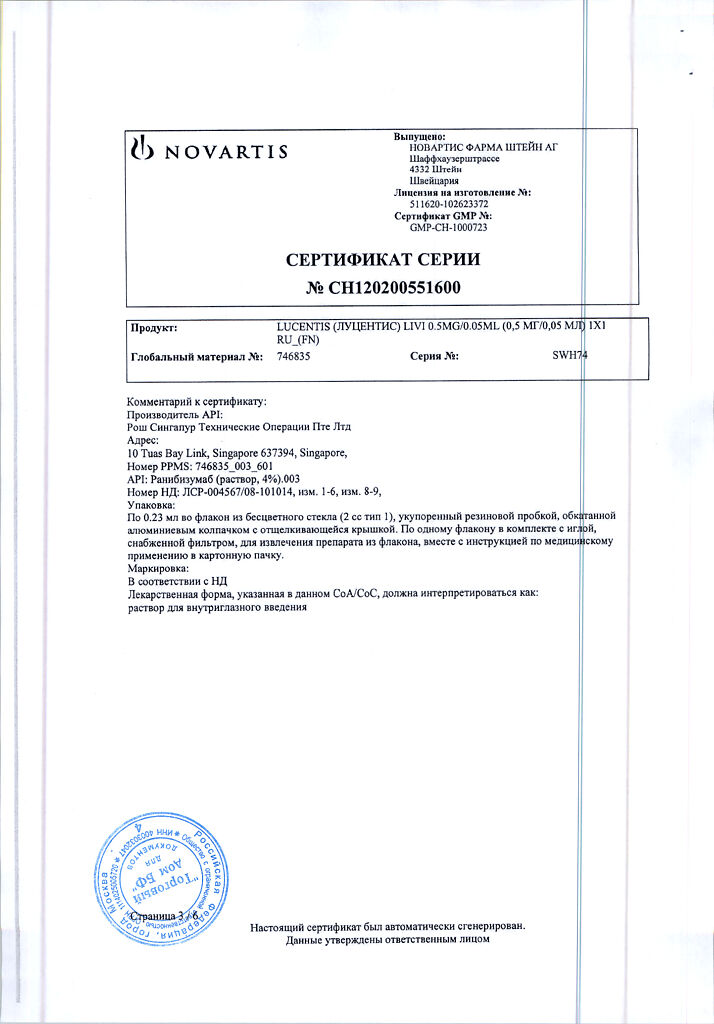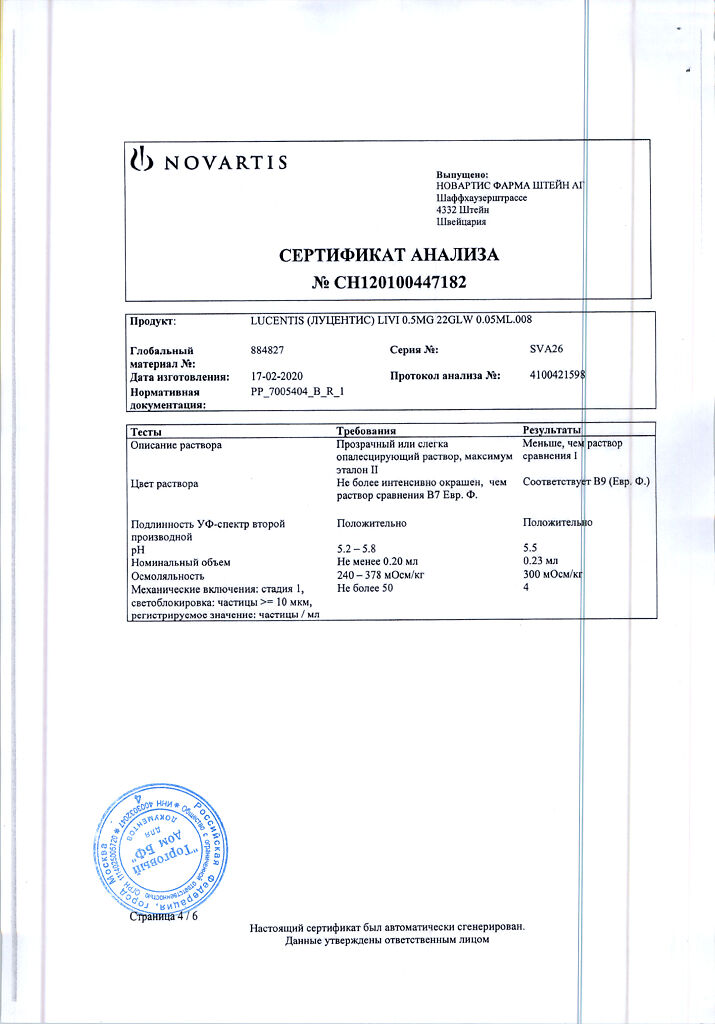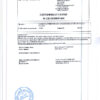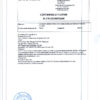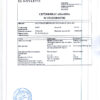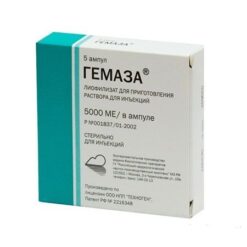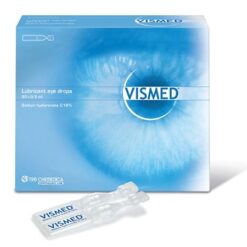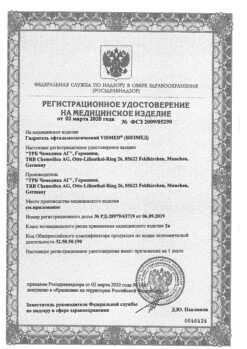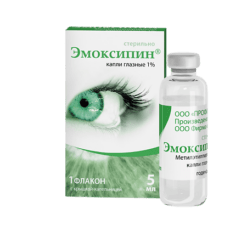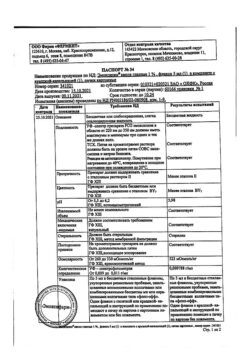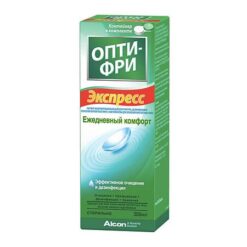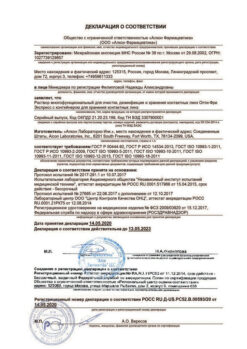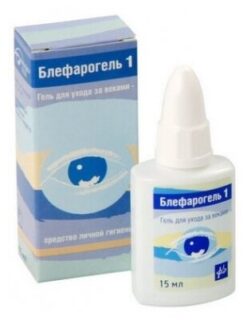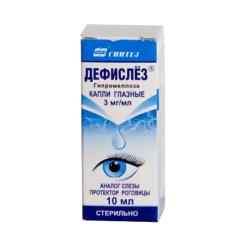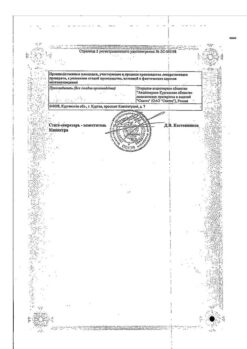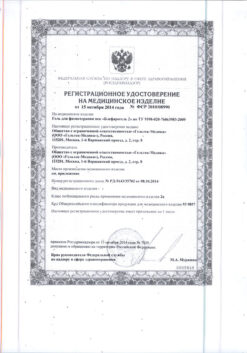No products in the cart.
Lucentis, 10 mg/ml 0.23 ml
€1.00
Out of stock
(E-mail when Stock is available)
Description
Lucentis is an angiogenesis inhibitor.
Pharmacodynamics
Ranibizumab is a fragment of humanized antibody to endothelial growth factor A (VEGF-A) and is expressed by a recombinant Escherichia coli strain.
Ranibizumab selectively binds to isoforms of vascular endothelial growth factor,VEGF-A (VEGF110, VEGF121, VEGF165), and prevents interaction of VEGF-A with its receptors on the surface of endothelial cells (VEGR1 and VEGR2), leading to suppression of neovascularization and vascular proliferation. By suppressing the growth of newly formed chorioidea vessels into the retina, ranibizumab stops the progression of the exudative-hemorrhagic form of age-related macular degeneration (AMD) and macular edema in diabetes and retinal vein occlusion (thrombosis).
. Administration of ranibizumab for 24 months in patients with TMD with minimally severe classic and occult subfoveal chorioidal neovascularization (CNV) significantly reduced the risk of visual acuity (VA) reduction in most cases (90%) (loss of less than 15 letters on the ETDRS VA definition scale or 3 lines on the Snellen table), One-third of patients (33%) showed an improvement in OZ of 15 letters or more on the ETDRS (3 lines on the Snellen Table) and an improvement in OZ of more than 15 letters on the ETDRS were observed in 53 and 4% of cases, respectively.
The majority of patients (90%) suffering from TMD with predominantly classical subfoveal CV, on the background of treatment with ranibizumab within 24 months reduced the frequency of development of marked visual impairment (by more than 3 lines), one third of patients (41%) had improvement of OZ (by more than 3 lines). In the group of patients receiving photodynamic therapy with verteporfin (vFDT), a decrease in the risk of OZ reduction (by more than 3 lines) and improvement of OZ (by more than 3 lines) were observed in 64 and 6% of cases, respectively. According to the NEI – VFQ (National Eye Institute – Visual Function Questionnaire), after 12 months of using ranibizumab in patients with TMD with minimally severe classical and occult subfoveal CVD, the mean improvement in near and far vision compared to baseline was 10.4 and 7 letters, respectively (p
The majority of patients with TMD with predominantly classical subfoveal CVD had a mean change in near and far vision over 12 months compared to baseline of +9.1 and +9.3 letters, respectively (p
In most patients with a decrease in near and far vision compared to baseline of +9.1 and +9.3 letters, respectively. In patients with decreased OZ associated with diabetic macular edema (DME), the change in OZ after 12 months of therapy compared with baseline was +6.8 letters on ranibizumab monotherapy, +6,4 letters – when combining ranibizumab with laser photocoagulation (LC) and 0.9 letters – with LC only (p
DRS was observed in 22.6, 22.9 and 8.2 patients receiving ranibizumab alone, the drug in combination with LC and LC only, respectively (p
)./p>
When ranibizumab was used for 12 months (if needed in combination with LC) in patients with DMO-related OZ reduction, the mean change in OZ from baseline was +10.3 letters compared with -1.4 letters for simulated injection. Improvements in OZ of more than 10 and 15 letters on the ETDRS scale were seen in 60.8 and 32.4% of patients treated with ranibizumab, compared with 18.4 and 10.2% with simulated injection (p
Stopping the drug was possible when stable OZ scores were achieved at three consecutive examinations. If resumption of treatment with ranibizumab was necessary, at least 2 consecutive monthly injections of the drug were performed.
With the use of ranibizumab, there was a marked persistent reduction in the thickness of the central zone of the retina as measured by optical coherence tomography. After 12 months of therapy with ranibizumab, retinal thickness in the central zone decreased by 194 μm compared to 48 μm when using simulated injection. The safety profile of the drug in patients with DMD was similar to that of wet AMD treatment.
In patients with decreased OZ caused by macular edema due to retinal vein occlusion, the change in OZ after 12 months of therapy compared with baseline was +18.3 letters with ranibizumab therapy in combination with LC, +12.1 letters with ranibizumab therapy after 6 months of simulated injection in combination with LC. Improvement of OZ by more than 15 letters on the ETDRS scale was seen in 60.3 and 43.9% of patients treated with ranibizumab or ranibizumab after use of simulated injection. When both therapies were administered for one day, ranibizumab was administered at least 30 minutes after LC.
In patients with decreased OZ caused by macular edema due to central retinal vein occlusion (CRV), the change in OZ after 12 months of therapy compared with baseline was +13.9 letters with ranibizumab monotherapy and +7.3 letters with ranibizumab therapy after 6 months using simulated injection.
OH improvement of more than 15 letters on the ETDRS scale was seen in 50.8 and 33.1% of patients treated with ranibizumab or ranibizumab after use of simulated injection.
The use of ranibizumab in both cases showed a pronounced persistent reduction in central retinal thickness.
In patients with CNS-induced decreased OZ caused by pathological myopia (PM), the change in OZ after 1-3 months of therapy compared to the initial value was +10.5 letters with ranibizumab therapy depending on the achievement of OZ stabilization criteria, +10.6 letters with ranibizumab therapy depending on disease activity; change in OZ after 6 months of therapy compared to the initial value was +11.9 letters and + 11.7 letters, respectively; after 12 months – +12.8 and +12.5 letters, respectively. In assessing the dynamics of the average OZ changes from the baseline value over 12 months, rapid achievement of the results was recorded, with the maximum improvement already achieved by the 2nd month. Improvement in OZ was maintained throughout the 12-month period.
The proportion of patients with an increase in OZ of 10 letters or more or reaching a value of ≥84 letters was higher with ranibizumab compared to wFDT. After 3 months of therapy, an increase in OZ by 10 letters or more (or achieving an OZ value ≥84 letters) compared to the baseline value was observed in 61.9% of patients against ranibizumab therapy, depending on the achievement of OZ stabilization criteria, and in 65.5% of patients against ranibizumab therapy depending on disease activity; after 6 months – in 71.4 and 64.7% of patients, respectively; after 12 months – in 69.5 and 69% of patients, respectively.
The increase in OZ by 10 letters or more (or achievement of OZ ≥84 letters) in the vFDT group after 3 months of therapy was observed in only 27.3% of patients.
In 3 months of therapy, an increase in OZ of 15 letters or more (or achievement of OZ ≥84 letters) compared with baseline was observed in 38.1% of patients on ranibizumab therapy depending on achievement of OZ stabilization criteria and in 43.1% of patients on ranibizumab therapy depending on disease activity; after 6 months, in 46.7 and 44.8% of patients, respectively; after 12 months, in 53.3 and 51.7% of patients, respectively.
A 15-letter or greater increase in OZ (or achievement of an OZ ≥84 letters) in the vFDT group after 3 months of therapy was observed in only 14.5% of patients.
It should be noted that patients who were monitored and resumed therapy based on disease activity criteria had, on average, one fewer injection per 12-month period than patients who received therapy based on achieving OZ stabilization criteria.
No adverse effect on OZ was detected immediately after suspension of therapy. After resumption of therapy, there was a recovery of lost OZ within one month.
There was a decrease in the proportion of patients with subretinal fluid, intraretinal edema and/or intraretinal cysts from baseline and an improvement in the overall NEI – VFQ-25 score.
Pharmacokinetics
Injecting ranibizumab into the vitreous (once a month) in patients with neovascular TMD Cmax of ranibizumab in plasma was low and insufficient to inhibit the biological activity of VEGF-A by 50% (11-27 ng/mL according to in vitro cell proliferation studies). When ranibizumab was injected into the vitreous in the dose range of 0.05 to 1 mg Cmax in plasma was proportional to its dose.
Based on the results of the pharmacokinetic analysis and considering the plasma excretion of ranibizumab, the average T1/2 of ranibizumab (0.5 mg dose) from the vitreous averaged about 9 days.
Injection of ranibizumab into the vitreous body (once a month), the plasma concentration of ranibizumab reaches a maximum value within 24 hours after injection and ranges from 0.79-2.9 ng/mL. Cmin of ranibizumab in plasma is in the range of 0.07-0.49 ng/ml. The serum concentration of ranibizumab is approximately 90,000 times lower than that in the vitreous.
Particular patient groups
In patients with impaired renal function. No specific pharmacokinetic studies on the use of ranibizumab have been performed in patients with impaired renal function. Sixty-eight percent (136 of 200) of the TMD patients included in the pharmacokinetic analysis had impaired renal function (46.5% mild, 20% moderate, and 1.5% severe). Kidney dysfunction was present in 48.2% (253 of 525) of the patients with retinal vein occlusion (RVC) (36.4% mild, 9.5% moderate, and 2.3% severe). In patients with impaired renal function, there was a minimal decrease in clearance of ranibizumab with no clinical significance during treatment with the drug.
Hepatic impairment. No specific pharmacokinetic studies on the use of ranibizumab have been performed in patients with impaired liver function.
Indications
Indications
treatment of neovascular (wet) form of age-related macular degeneration in adults;
treatment of decreased visual acuity associated with diabetic macular edema as monotherapy or in combination with LC in patients who have previously undergone LC;
treatment of decreased visual acuity caused by macular edema due to occlusion of the retinal veins (RVS or its branches);
treatment of decreased visual acuity caused by choroidal neovascularization due to pathological myopia.
Pharmacological effect
Pharmacological effect
Lucentis – angiogenesis inhibitor.
Pharmacodynamics
Ranibizumab is a humanized anti-endothelial growth factor A (VEGF-A) antibody fragment expressed by a recombinant Escherichia coli strain.
Ranibizumab selectively binds to isoforms of the vascular endothelial growth factor, VEGF-A (VEGF110, VEGF121, VEGF165), and prevents the interaction of VEGF-A with its receptors on the surface of endothelial cells (VEGR1 and VEGR2), which leads to the suppression of neovascularization and vascular proliferation. By inhibiting the growth of newly formed choroidal vessels into the retina, ranibizumab stops the progression of the exudative-hemorrhagic form of age-related macular degeneration (AMD) and macular edema in diabetes mellitus and retinal vein occlusion (thrombosis).
When ranibizumab was used for 24 months in patients with AMD with minimally expressed classical and hidden subfoveal choroidal neovascularization (CNV), in most cases (90%) the risk of decreased visual acuity (VA) was significantly reduced (loss of less than 15 letters on the ETDRS VA scale or 3 lines on the Snellen chart), in a third of patients (33%) there was an improvement in VA by 15 letters or more on the ETDRS scale. (pETDRS (3 lines on the Snellen chart) and improvement in VA by more than 15 letters on the ETDRS scale were noted in 53 and 4% of cases, respectively.
In the majority of patients (90%) suffering from AMD with predominantly classic subfoveal CNV, treatment with ranibizumab for 24 months reduced the incidence of severe vision loss (by more than 3 lines); a third of patients (41%) showed an improvement in VA (by more than 3 lines). In the group of patients receiving photodynamic therapy with verteporfin (vPDT), a decrease in the risk of a decrease in VA (by more than 3 lines) and an improvement in VA (by more than 3 lines) were observed in 64 and 6% of cases, respectively. According to the NEI quality of life questionnaire – VFQ (National Eye Institute – Visual Function Questionnaire), after 12 months of ranibizumab use in patients with AMD with minimally expressed classical and hidden subfoveal CNV, the average improvement in VA near and far compared to the initial value ranged from 10.4 and 7 letters, respectively (p
In the majority of patients suffering from AMD with predominantly classical subfoveal CNV, during treatment with the drug for 12 months, the average change in VA near and far compared to the initial value ranged from +9.1 and +9.3 letters, respectively (p
In patients with a decrease in VA associated with diabetic macular edema (DME), the change in VA after 12 months of therapy compared to the initial value was +6.8 letters with ranibizumab monotherapy, +6.4 letters with the combination of ranibizumab with laser coagulation (LC) and 0.9 letters with LC only (pETDRS was observed in 22.6, 22.9 and 8.2 patients who received only ranibizumab, the drug in combination with LA and only LA, respectively (p
When ranibizumab was used for 12 months (in combination with LC if necessary) in patients with decreased VA associated with DME, the mean change in VA from baseline was +10.3 letters compared with −1.4 letters with sham injection. Improvement in VA by more than 10 and 15 letters on the ETDRS scale was observed in 60.8 and 32.4% of patients receiving ranibizumab, compared with 18.4 and 10.2% with sham injection (p
Discontinuation of drug administration was possible when stable VA values were achieved during three consecutive examinations. If it was necessary to restart treatment with ranibizumab, at least 2 consecutive monthly injections of the drug were administered.
With the use of ranibizumab, a pronounced, persistent decrease in the thickness of the central zone of the retina, measured using optical coherence tomography, was observed. After 12 months of ranibizumab therapy, central retinal thickness decreased by 194 µm compared to 48 µm with sham injection. The safety profile of the drug in patients with DME was similar to that in the treatment of wet AMD.
In patients with a decrease in VA caused by macular edema due to occlusion of the branches of the retinal veins, the change in VA after 12 months of therapy compared to the initial value was +18.3 letters during therapy with ranibizumab in combination with LA, +12.1 letters during therapy with ranibizumab after 6 months of using a sham injection in combination with LA. Improvement in VA of more than 15 letters on the ETDRS scale was observed in 60.3 and 43.9% of patients receiving ranibizumab or ranibizumab after sham injection. When both treatments were administered on the same day, ranibizumab was administered at least 30 minutes after LC.
In patients with a decrease in VA caused by macular edema due to central retinal vein occlusion (CRVO), the change in VA after 12 months of therapy compared to the initial value was +13.9 letters during ranibizumab monotherapy, +7.3 letters during ranibizumab therapy after 6 months of sham injection.
Improvement in VA of more than 15 letters on the ETDRS scale was observed in 50.8 and 33.1% of patients receiving ranibizumab or ranibizumab after sham injection.
With the use of ranibizumab in both cases, a pronounced persistent decrease in the thickness of the central zone of the retina was observed.
In patients with a decrease in VA caused by CNV caused by pathological myopia (PM), the change in VA after 1–3 months of therapy compared to the initial value was +10.5 letters during ranibizumab therapy, depending on the achievement of VA stabilization criteria, +10.6 letters — during ranibizumab therapy, depending on disease activity; the change in VA after 6 months of therapy compared to the initial value was +11.9 letters and + 11.7 letters, respectively; after 12 months – +12.8 and +12.5 letters, respectively. When assessing the dynamics of average changes in VA from the initial value over 12 months, rapid achievement of results was recorded, with maximum improvement achieved already by the 2nd month. The improvement in VA was maintained throughout the 12-month period.
The proportion of patients with an increase in VA of 10 letters or more or achieving a value of ≥84 letters was higher with ranibizumab compared with vPDT. After 3 months of therapy, an increase in VA by 10 letters or more (or achievement of VA ≥84 letters) compared to the initial value was observed in 61.9% of patients during ranibizumab therapy, depending on the achievement of VA stabilization criteria, and in 65.5% of patients during ranibizumab therapy, depending on disease activity; after 6 months – in 71.4 and 64.7% of patients, respectively; after 12 months – in 69.5 and 69% of patients, respectively.
An increase in VA by 10 letters or more (or achievement of VA ≥84 letters) in the vPDT group after 3 months of therapy was observed only in 27.3% of patients.
After 3 months of therapy, an increase in VA by 15 letters or more (or achievement of VA ≥84 letters) compared to the initial value was observed in 38.1% of patients during ranibizumab therapy, depending on the achievement of VA stabilization criteria, and in 43.1% of patients during ranibizumab therapy, depending on disease activity; after 6 months – in 46.7 and 44.8% of patients, respectively; after 12 months – in 53.3 and 51.7% of patients, respectively.
An increase in VA by 15 letters or more (or achievement of VA ≥84 letters) in the vPDT group after 3 months of therapy was observed only in 14.5% of patients.
It should be noted that in patients who were monitored and restarted based on disease activity criteria, the number of injections over a 12-month period was on average one less than in patients who received therapy based on achieving VA stabilization criteria.
There was no negative effect on VA immediately after discontinuation of therapy. After resumption of therapy, recovery of lost VA was observed within one month.
There was a decrease in the proportion of patients with subretinal fluid, intraretinal edema, and/or intraretinal cysts compared with baseline, and an improvement in the overall NEI-VFQ-25 score.
Pharmacokinetics
When ranibizumab was administered intravitreally (once a month) to patients with neovascular AMD, the Cmax of ranibizumab in the blood plasma was low and insufficient to inhibit the biological activity of VEGF-A by 50% (11–27 ng/ml according to in vitro cell proliferation studies). When intravitreal ranibizumab was administered over a dose range of 0.05 to 1 mg, plasma Cmax was dose proportional.
Based on the results of the pharmacokinetic analysis and taking into account the elimination of ranibizumab from blood plasma, the mean T1/2 of ranibizumab (0.5 mg dose) from the vitreous averaged about 9 days.
When ranibizumab is administered into the vitreous body (once a month), the concentration of ranibizumab in the blood plasma reaches its maximum value within 24 hours after injection and is in the range of 0.79–2.9 ng/ml. Cmin of ranibizumab in blood plasma is in the range of 0.07–0.49 ng/ml. The concentration of ranibizumab in the blood serum is approximately 90,000 times lower than that in the vitreous.
Special patient groups
Renal dysfunction. Specific pharmacokinetic studies on the use of ranibizumab have not been conducted in patients with impaired renal function. 68% (136 of 200) of patients with AMD included in the pharmacokinetic analysis had renal impairment (46.5% mild, 20% moderate, and 1.5% severe). 48.2% (253 of 525) of patients with retinal vein occlusion (RVO) had renal dysfunction (36.4% mild, 9.5% moderate, and 2.3% severe). During treatment with the drug in patients with impaired renal function, a minimal decrease in the clearance of ranibizumab was observed, which had no clinical significance.
Liver dysfunction. Specific pharmacokinetic studies on the use of ranibizumab have not been conducted in patients with impaired liver function.
Special instructions
Special instructions
Treatment with the drug should only be carried out by an ophthalmologist with experience in performing intravitreal injections. The administration of Lucentis should always be carried out under aseptic conditions. In addition, the patient must be monitored for 1 week after injection of the drug in order to identify a possible local infectious process and provide timely therapy. Patients should be informed of the need to immediately report to the doctor any symptoms that may indicate the development of endophthalmitis.
The drug has immunogenic properties. Since patients with DME have a higher risk of systemic exposure to the drug, it is necessary to remember the higher risk of developing hypersensitivity reactions in this category of patients.
Patients should be aware of signs indicating the development of intraocular inflammation, which may indicate intraocular formation of antibodies to the drug.
When injecting endothelial growth factor A (VEGF-A) inhibitors into the vitreous, arterial thromboembolic complications may develop. The risk of stroke may be higher if patients have risk factors, including a previous stroke or a history of transient cerebrovascular accidents.
In patients after administration of Lucentis, a temporary (within 60 minutes after injection) increase in IOP was observed. There were also cases of persistent increase in IOP. During the use of Lucentis, it is recommended to monitor IOP and perfusion of the optic nerve head.
Lucentis is not recommended for administration into both eyes at the same time (the safety and effectiveness of this administration have not been studied). This may result in increased systemic exposure to Lucentis and the risk of side effects.
Experience with Lucentis is limited in patients with DME due to type 1 diabetes mellitus, in patients previously treated with intraocular medications, in patients with active systemic infections, with proliferative diabetic retinopathy, or with concomitant non-infectious ocular diseases such as retinal detachment, incl. in the area of the macula. There is also no experience with the use of Lucentis in patients with diabetes with a glycated hemoglobin level of more than 12% and uncontrolled arterial hypertension.
Experience with Lucentis is limited in patients with PM who have previously undergone unsuccessful vPDT. Although similar effects were observed in patients with subfoveal and juxtafoveal lesions, there is insufficient data to draw conclusions regarding the effectiveness of Lucentis in patients with PM with extrafoveal lesions.
When carrying out drug therapy, women of childbearing age should use reliable methods of contraception.
Impact on the ability to drive vehicles and operate machinery. While using the drug Lucentis, it is possible to develop temporary visual impairments that negatively affect the ability to drive vehicles and operate machinery. If such symptoms occur, patients should not drive vehicles or operate machinery until the severity of temporary visual disturbances decreases.
Directions for use
The contents of one vial of Lucentis should be used for only one intravitreal injection.
The Lucentis kit includes a needle equipped with a filter to remove the contents from the vial, a syringe and an injection needle (yellow).
The preparation of Lucentis solution for intravitreal injection should be carried out as follows:
1. Before opening the bottle with the drug, the surface of the rubber stopper should be disinfected.
2. Under aseptic conditions, connect the supplied syringe (1 ml capacity) with a needle equipped with a filter (the pore size of which is 5 microns). Insert a needle equipped with a filter into the bottle through the central part of the rubber stopper (the end of the needle should reach the bottom of the bottle).
3. Draw the entire contents of the bottle into a syringe, holding the bottle in a vertical position and slightly tilting it (to completely remove the solution).
4. After removing the drug from the bottle, the syringe plunger should be moved back (to the 0.8-0.9 ml mark) to completely transfer the solution from the needle equipped with a filter into the syringe.
5. Then disconnect the needle equipped with a filter from the syringe and leave it in the bottle. After removing the solution from the vial into the syringe, the needle equipped with a filter should be disposed of properly.
Attention: a needle equipped with a filter cannot be used for intravitreal injection.
6. Under aseptic conditions, connect the syringe tightly to the injection needle.
7. Carefully remove the cap from the injection needle (the needle should remain attached to the syringe).
Caution: When removing the cap from the intravitreal injection needle, you should only touch the cannula of the intravitreal injection needle.
8. Carefully remove air from the syringe and set the plunger to the 0.05 ml mark. Only after this can the drug be injected into the vitreous body.
Attention: do not touch the injection needle and move the piston back (after setting at the 0.05 ml mark).
If, after a single injection into the vitreous body, an unused solution of the drug remains in the vial, it should be disposed of properly (re-use of unused solution is unacceptable).
Active ingredient
Active ingredient
Ranibizumab
Composition
Composition
Active ingredient:
ranibizumab;
Excipients:
α,α-trehalose dihydrate;
L-histidine hydrochloride monohydrate;
L-histidine; polysorbate 20;
water for injections
Pregnancy
Pregnancy
Use during pregnancy and breastfeeding is not recommended.
The systemic exposure of ranibizumab after intraocular administration is low, but taking into account the mechanism of action of the drug, ranibizumab should be considered as a potentially teratogenic and embryotoxic drug.
Women of childbearing age are advised to use contraceptive methods when using Lucentis.
The interval between the end of treatment with Lucentis and conception should not be less than 3 months.
Contraindications
Contraindications
hypersensitivity to ranibizumab or any other component of the drug;
confirmed or suspected eye infections or infectious processes of periocular localization;
intraocular inflammation;
pregnancy;
lactation period;
children under 18 years of age (the effectiveness and safety of the drug in this category of patients has not been studied).
With caution: if the patient has one of the listed diseases, be sure to consult a doctor before using the drug. In patients with a known history of hypersensitivity or risk factors for stroke, the drug should be administered only after a careful assessment of the risk/benefit ratio. The use of VEGF inhibitors in patients with diabetic macular edema and macular edema due to RVO and choroidal neovascularization due to pathological myopia, with a history of stroke or transient cerebral ischemia, should be used with caution due to the risk of thromboembolic events. Lucentis should not be used concomitantly with other drugs that affect vascular endothelial growth factor (local or systemic use).
Side Effects
Side Effects
Infections and infestations: very often – nasopharyngitis; often – influenza, urinary tract infection (observed only in patients with DME).
From the hematopoietic system: often – anemia.
Mental disorders: often – anxiety.
From the nervous system: very often – headache; infrequently – stroke.
From the organ of vision: very often – intraocular inflammation, inflammation of the vitreous body, vitreous detachment, retinal hemorrhages, visual disturbances, pain in the eyes, opacities in the vitreous body, increased IOP, conjunctival hemorrhages, eye irritation, feeling of a foreign body in the eyes, lacrimation, blepharitis, dry eye syndrome, redness of the eyes, itching in the eyes; often – degenerative changes in the retina, retinal damage, retinal detachment, retinal breaks, detachment of the retinal pigment epithelium, rupture of the pigment epithelium, decreased VA, vitreous hemorrhage, vitreous damage, uveitis, iritis, iridocyclitis, cataract, subcapsular cataract, opacification of the posterior lens capsule, punctate keratitis, erosion corneas, cellular opalescence in the anterior chamber of the eye, blurred vision, hemorrhage at the injection site, ocular hemorrhages, conjunctivitis, allergic conjunctivitis, discharge from the eyes, photopsia, photophobia, discomfort in the eyes, swelling of the eyelids, soreness of the eyelids, conjunctival hyperemia; uncommon – blindness, endophthalmitis, hypopyon, hyphema, keratopathy, iris adhesions, corneal deposits, corneal edema, corneal striae, pain and irritation at the injection site, atypical sensations in the eye and irritation of the eyelids.
From the respiratory system: often – cough.
From the digestive system: often – nausea.
Dermatological disorders: often – allergic reactions (rash, urticaria, itching, erythema).
From the musculoskeletal system: very often – arthralgia.
Interaction
Interaction
The interaction of Lucentis with other drugs has not been studied.
Lucentis should not be mixed with any other drugs or diluents.
Overdose
Overdose
Symptoms: in clinical studies and when using the drug in clinical practice, cases of unintentional overdose of the drug were observed. In these cases, with an overdose of the drug Lucentis, an increase in IOP and pain in the eye were most often observed.
Treatment: in case of drug overdose, IOP must be monitored; if necessary, the patient should be under the supervision of a physician.
Storage conditions
Storage conditions
In a place protected from light, at a temperature of 2–8 °C (do not freeze)
Shelf life
Shelf life
3 years
Manufacturer
Manufacturer
Novartis Pharma GmbH, Germany
Additional information
| Shelf life | 3 years |
|---|---|
| Conditions of storage | In the dark place at 2-8 °C (do not freeze) |
| Manufacturer | Novartis Pharma GmbH, Germany |
| Medication form | solution |
| Brand | Novartis Pharma GmbH |
Related products
Buy Lucentis, 10 mg/ml 0.23 ml with delivery to USA, UK, Europe and over 120 other countries.


